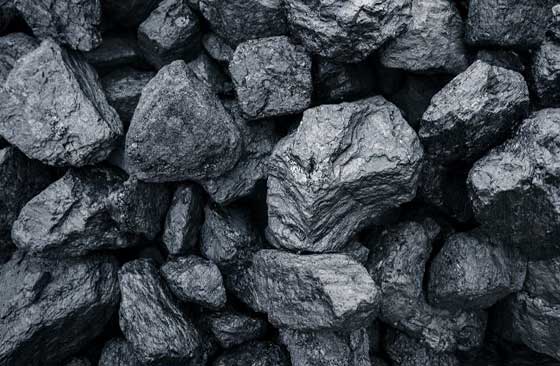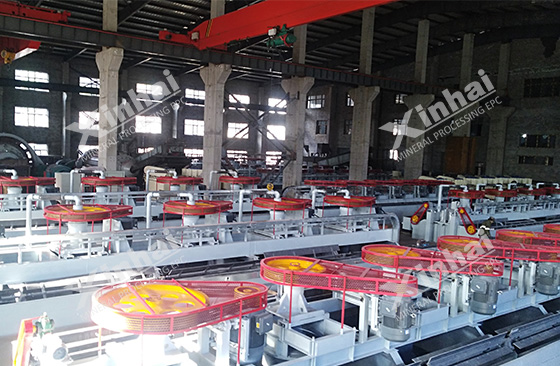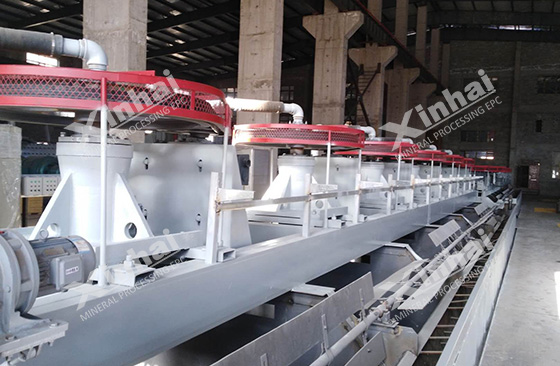
Graphite is a non-metallic mineral with excellent physical and chemical properties. It has the advantages of high temperature resistance, strong electrical and thermal conductivity, and therefore has been widely used in national defense, metallurgical machinery and other industries. New graphites such as graphene, spherical graphite, and flexible graphite have better performance and better application prospects. With the continuous development and utilization of mineral resources, high-quality and easy-to-select graphite ores are gradually decreasing. In order to meet the needs of market production, it is imperative to develop and utilize complex and difficult-to-select graphite ores. Graphite with large flakes is naturally hydrophobic and has good floatability, so the flotation process can be used to recover the concentrate. However, graphite ore with smaller flakes, fine embedded particles and good grade requires a more complex beneficiation process. It can be seen that depending on the type of graphite ore, the mineral processing process used is also different. The following will introduce you to the types of graphite and the commonly used beneficiation methods for graphite ores.

1. From the perspective of industrial application, graphite ores deposits can be divided into five major types:
(1) Layered graphite deposits in crystalline schist;
(2) Graphite deposits in metamorphic coal seams;
(3) Graphite deposits in nepheline syenite;
(4) Graphite deposits in skarn;
(5) Vein-like graphite deposits in crystalline flakes.
2. Graphite ore can be divided into two types in terms of crystallization form: crystalline graphite ore and cryptocrystalline graphite ore.
Commonly used graphite ores beneficiation methods include flotation, gravity separation, electric separation, etc., among which flotation is widely used. The concentrate grade obtained by conventional graphite beneficiation methods is generally around 97%. To obtain higher grade graphite, appropriate purification methods are required, such as high-temperature alkali acid leaching, acid leaching, chlorine roasting, etc.

1. Flotation method
Flake graphite ores can be processed by flotation due to its good hydrophobicity. Commonly used flotation collectors are non-polar hydrocarbon oils, such as kerosene, diesel, heavy oil, etc. Some mineral processing plants use new collectors, such as phenols, sulfonate esters or carboxylate esters. The quality of cryptocrystalline graphite ores cannot be greatly improved through flotation, but its raw ore has a high content of fixed carbon. The concentrate and tailings obtained after flotation can be sold as products of different grades. When the content of silicate minerals in graphite ore is high, water glass, starch, cellulose, etc. can be selected for suppression. If the pyrite content in the ore is high, quicklime can be added to the slurry to adjust the pH value and suppress it.
2. Gravity separation method
The gravity separation method is a method of physical separation based on the density difference between graphite ore and other gangue minerals. The components in graphite ores can be divided into three categories: heavy minerals, medium specific gravity minerals, and light minerals according to different specific gravity. The different specific gravity of graphite and gangue minerals are then used for gravity separation to obtain graphite rough concentrate. The graphite gravity separation method generally adopts wet gravity separation, and the main equipment is a shaking table. It is difficult to obtain ideal beneficiation indicators by using gravity separation alone, so a combined flotation process is required. That is, after gravity separation is used to obtain the coarse concentrate, the flotation process is used to obtain graphite concentrate.

3.Electric selection method
The electrical conductivity of graphite is due to other gangue minerals such as quartz, mica, feldspar, etc., so this characteristic can be used for electrical separation to separate graphite from other gangue minerals. Because the electric separation method has small production capacity and low efficiency, the mineral separation effect is not as good as flotation, and it is rarely used in mineral processing plants.
When deep processing graphite ores, the grade of graphite concentrate needs to be increased to above 99%. This cannot be achieved with the above-mentioned conventional mineral processing methods, so the graphite concentrate needs to be purified. The purification methods are mainly divided into two types: chemical purification and high-temperature purification.
1. Chemical purification method: alkali and graphite concentrate are mixed and melted in a certain proportion. After melting, the gangue minerals and alkali react chemically to form water-soluble compounds. The melting reaction is carried out at 850℃. After the reaction is completed, it is washed with water. The sodium silicate is dissolved in water, and some substances are hydrolyzed in a weakly alkaline medium to form a highly dispersed precipitate. These precipitates are treated with high-concentration acid to prevent chemical combination, and then washed with water to obtain high-purity graphite.
2. High temperature purification method: The sublimation point of graphite can reach 4500℃, which is much higher than other impurities. When graphite is heated to 3000℃ in a purification furnace, low-boiling point substances volatilize, thereby obtaining graphite with a purity of more than 99%. In order to improve the purity of graphite, inert gas and other agents can be introduced during the heating process to allow volatile matter to escape with the gas.

The above content is a brief introduction to graphite ores types and mineral processing and purification methods. In actual production, the mineral processing plant should choose a reasonable mineral processing and purification method based on the mineral composition and characteristics of the graphite ore. Xinhai Mining recommends conducting mineral processing tests to determine the characteristics of the graphite ore to be selected and customize the mineral processing method. Xinhai Mining can provide you with We provide customized graphite beneficiation processes and equipment to help you recycle graphite concentrate more efficiently, improve beneficiation efficiency while reducing resource waste.
To find out more about our products and solutions, please fill out the form below and one of our experts will get back to you shortly.